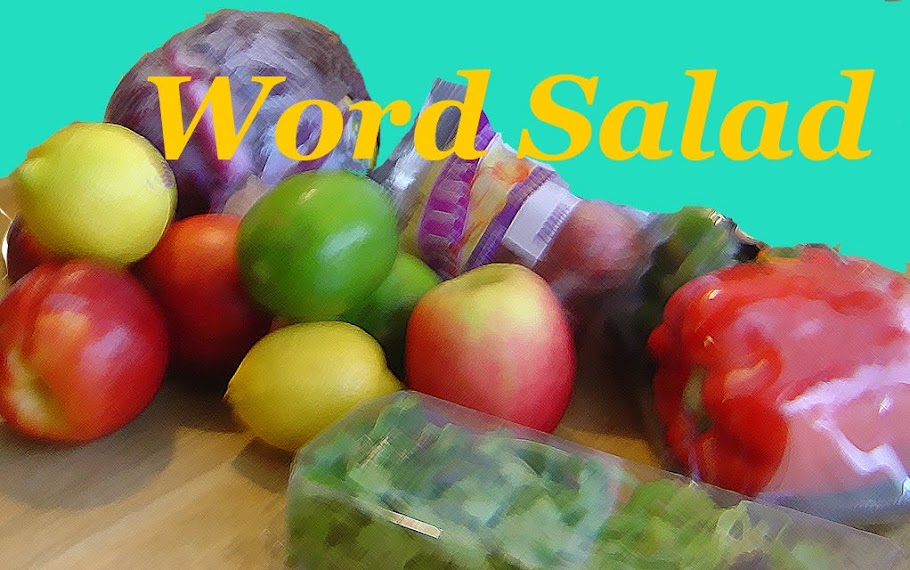“Don’t you have a blog to tend to?” Wink asked in a recent thread on the OT. I forget what exactly I had done to annoy her, but I find that sometimes simply posting while elderly is enough to clue my juniors into the fact that they are not going to be young forever, either. At any rate, she is right, of course, but I have been facing blogger’s block, if there is such a thing.
A few days later, in that day’s lunch thread*, a new poster responded to someone’s mulling over whether to have a salad with the words, “No good story ever started with ‘I’ll have the salad’.”
“Has any good story ever started with, “I’ll have the steak?” I asked. Back in my day, calling someone a “meat and potatoes man” (and it was never a “meat and potatoes woman”, because she was having the salad) was a way of describing him as manly but unadventurous. A man’s man, but in the sense that he drank and cussed and knew how to fix the plumbing, not in the sense that he could make his way through a new country and blend in with the inhabitants while eluding spies. “Plenty of them,” our new poster (whose name abbreviates to SOS) maintained. So being the literal minded soul I am, I asked for titles and authors.
Of the ensuing spat let me just say that it turned out that SOS meant that no adventures start with safe choices, and that he backed down graciously when another poster told him that I have a blog about salad, so that I didn’t like to see salad disrespected. I bumped into SOS a little later on a thread about the upcoming New Orleans Jazz fest, and had to tease him that one year we had gone both weekends with a Danish foreign exchange student, “who (and I am not making this up) loved to make salads.” At this point SOS decided that maybe it was better to say, “No good story ever started with ‘I’ll have the soup’.”
But this led to my asking myself, if by story we mean someone’s personal narrative and not a written story, then how do we decide where the story started? Since my last post was penguin pictures taken in Antarctica, let’s take that story as an example. I first came to the realization I could go to Antarctica when I got a brochure for an Antarctic cruise from my alumni association, but my interest in the White Continent was piqued years earlier, when I read the book, Mind Over Matter: The Epic Crossing of the Antarctic Continent, by Sir Ranulph Fiennes. I subsequently read a few other books by Sir Ranulph and think I can safely say that he probably never started an adventure with the words, “I’ll have the salad.” Perhaps the words, “That explosion was a little more powerful than I intended,” but not, “I’ll have the salad.”
However, reading the book did not leave me with a concrete plan for getting myself to Antarctica, and I had pretty much forgotten it by time the cruise brochure arrived in the mail, a few months before our fifth and last foreign exchange student, Laura, arrived at our door. I looked it over, wondering how I could convince my husband to go, and how I could convince Laura’s parents to let us take her along. Laura solved the latter problem by asking to go to another host family, but before she moved on, we took her out to dinner at a nearby restaurant. We had to sit and wait for a table, and the person waiting opposite me was holding a menu, with the desserts prominently displayed on the back. I must have been on a diet back then, because I grumped about being confronted with pictures of gooey desserts. Laura promptly placed her hand between me and the pictures, saying, “So” with her usual Gallic charm.
It took three years, but I date that dinner as the beginning of my story of how we went to Antarctica. That means, that yes, my adventure began with the words, “I’ll have the salad.”
 |
| Remains of our salad at La Nazarenas, Buenos Aires |
*There are three daily threads that are referred to as IM threads: the Good Morning Thread, the Lunch Thread, and the LNST (Late Night Snack Thread). That’s why I find myself drawn to the OT. It is the hangout for bigots, MRA’s, would-be PUA’s, fat-shamers, slut-shamers, and assorted types who are different from me, but this ongoing habit of checking in with each other every morning, noon, and night is kind of, well, there is no other word for it, sweet.







